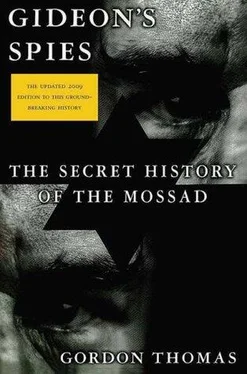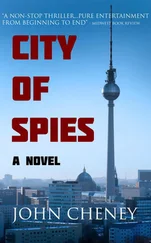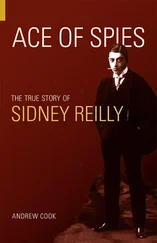Gordon Thomas - Gideon's Spies
Здесь есть возможность читать онлайн «Gordon Thomas - Gideon's Spies» весь текст электронной книги совершенно бесплатно (целиком полную версию без сокращений). В некоторых случаях можно слушать аудио, скачать через торрент в формате fb2 и присутствует краткое содержание. Город: New York, Год выпуска: 2009, ISBN: 2009, Издательство: Thomas Dunne Books, Жанр: История, на английском языке. Описание произведения, (предисловие) а так же отзывы посетителей доступны на портале библиотеки ЛибКат.
- Название:Gideon's Spies
- Автор:
- Издательство:Thomas Dunne Books
- Жанр:
- Год:2009
- Город:New York
- ISBN:978-0-312-53901-6
- Рейтинг книги:4 / 5. Голосов: 1
-
Избранное:Добавить в избранное
- Отзывы:
-
Ваша оценка:
- 80
- 1
- 2
- 3
- 4
- 5
Gideon's Spies: краткое содержание, описание и аннотация
Предлагаем к чтению аннотацию, описание, краткое содержание или предисловие (зависит от того, что написал сам автор книги «Gideon's Spies»). Если вы не нашли необходимую информацию о книге — напишите в комментариях, мы постараемся отыскать её.
Gideon’s Spies
Gideon's Spies — читать онлайн бесплатно полную книгу (весь текст) целиком
Ниже представлен текст книги, разбитый по страницам. Система сохранения места последней прочитанной страницы, позволяет с удобством читать онлайн бесплатно книгу «Gideon's Spies», без необходимости каждый раз заново искать на чём Вы остановились. Поставьте закладку, и сможете в любой момент перейти на страницу, на которой закончили чтение.
Интервал:
Закладка:
Clad in vest and shorts, Agca was an unprepossessing figure; large hands and feet were all out of proportion to his body with his concave chest, protruding shoulder blades, and skinny arms and legs. The first thing he did each morning, like the other recruits, was to spread his prayer rug and prostrate himself three times, each time touching his forehead to the ground, murmuring the name of Allah, Master of the World, the All-Meaningful and All-Compassionate, the Supreme Sovereign of the Last Judgment. Afterward he began to recite his long list of hatreds, which his instructor had encouraged him to write down. The list had grown long and diverse and included all imperialists, NATO, and those Arab countries that had refused to cut off oil from the West. He especially called upon Allah to destroy the United States, the most powerful nation on earth, and its people, praying that their way of life, their values and customs, the very wellspring of their existence, would be squeezed from them.
Finally only his religious hatreds remained. They were the most virulent, consuming him like a cancer, eating into his brain. He saw all other faiths as threatening to overthrow the one to which he subscribed. His instructors had taught him to reduce that hatred to one instantly recognizable image: a man, dressed in white, living in a huge palace far beyond the mountains. From there he ruled like a caliph of old, issuing decrees and orders many millions obeyed. The man spread his hated message the way his predecessors had done for over nineteen centuries. Supported by pomp and glory, rejoicing in even more titles than Allah, the man was known variously as Servant of the Servants of God, Patriarch of the West, Vicar of Christ on Earth, Bishop of Rome, Sovereign of the State of Vatican City, Supreme Pontiff, His Holiness Pope John Paul the Second.
Mehmet Ali Agca had been promised that, when the time came, he would be given a chance to kill the pope. His instructors drummed into him that it was no coincidence the pope had come to office at almost the same time as their beloved Khomeini delivered Iran from the shah’s regime. The “infidel in Rome,” as Agca was taught to refer to John Paul, had come to destroy the revolution the ayatollah had proclaimed in the name of the Holy Koran.
There was a grain of truth in the accusation. John Paul had increasingly spoken harshly about Islam and the dangers he believed it contained in its fundamentalist form. Visiting the Olivetti factory at Ivrea, Italy, John Paul had astonished the workers by inserting into his speech an impromptu passage:
“What the Koran teaches people is aggression; what we teach our people is peace. Of course, you always have human nature which distorts whatever message religion is sending. But even though people can be led astray by vices and bad habits, Christianity aspires to peace and love. Islam is a religion that attacks. If you start by teaching agression to the whole community, you end up pandering to the negative elements in everyone. You know what that leads to: such people will assault us.”
In January 1981, Agca had flown to Libya. Initially Mossad had been puzzled by that part of his journey, until an informer in Tripoli discovered that a renegade CIA officer, Frank Terpil, had been in the country at that time. Terpil had been indicted by a grand jury in Washington for supplying arms to Libya, conspiring to assassinate one of Gadhafi’s opponents in Cairo, recruiting former U.S. military pilots to fly Libyan aircraft, and Green Berets to run Gadhafi’s training camps for terrorists. In Libya he was instructing terrorists how to evade detection by Western security agencies. Terpil had moved on to Beirut—where he had disappeared. Mossad believed he had been murdered when he had outlived his usefulness.
Mossad knew Agca’s contact with Terpil had been arranged by Agca’s controllers in Tehran and leaked to the KGB after the attempted John Paul assassination, allowing for the Russians to claim the plot had been orchestrated by the CIA. Like Mossad, the KGB had an effective psychological warfare department. The fiction about the CIA filled thousands of column inches and many hours of broadcast time. To further muddy the waters, the Tehran mullahs arranged for Agca, after he left Libya in February 1981, to travel to Sofia, Bulgaria, to meet men who told him they were members of the country’s secret service: no convincing proof ever emerged they were. Furious at the KGB’s attempts to smear the Agency, the CIA countered by claiming the Bulgarians had controlled Agca on behalf of the Kremlin.
For Mossad the situation was perfectly poised to exploit the adage “We divide to rule.” Not only would Mossad be able to discredit the CIA with the Vatican, but at long last, by promoting their version of the plot as the correct one, Mossad had found a way to gain the pope’s ear. All else would flow from that: its officers could have access to the secretary of state’s own formidable information-collecting network; it would enable katsas to work with, and if need be, exploit priests and nuns; and, when the opportunity arose, those electronic bugs could finally be planted in all those holy places in the Vatican Zvi Zamir had indicated.
When Mossad’s account of Mehmet Ali Agca’s odyssey had been fully pieced together in Tel Aviv, Nahum Admoni set out to answer the one question that would make all that happen. Once more a computer search found the solution. One of Rafi Eitan’s “survivor spies,” a Catholic living in Munich, had described the extraordinary role Luigi Poggi played in the papacy. Nahum Admoni had sent for Eli and told him to make contact with Poggi.
Now, a full two years after Agca had shot the Pope, the archbishop sat far into the night, explaining completely to John Paul what Eli had told him.
A month later, on December 23, 1983, at 4:30 A.M., almost three hours before the lights on the Christmas tree in St. Peter’s Square would be switched off for the day, the pope was awoken by his valet.
The bedroom was surprisingly small, its walls still lined with the pastel linen covering his predecessor favored. The wooden floor, gleaming from being polished, was partly covered by a rug woven by Polish nuns. On the wall above the bed, in which four of John Paul’s predecessors had lain waiting for death, was a crucifix. On another wall was a fine painting of Our Lady. Both were gifts from Poland. In addition to the pope’s valet, those who saw him at this hour—usually one of his administrative priests with news that could not wait—were relieved to see John Paul had regained some of his old vigor and vitality.
As always, the pope began his day by going to his prie-dieu to kneel in private prayer. Afterward he shaved and showered and dressed in the clothes the valet had laid out: a heavy woolen white cassock caped around the shoulders, white clerical shirt, knee-high white stockings, brown shoes, and white skullcap. He was ready to go to see Agca in Rome’s Rebibbia Prison.
The meeting was arranged at the pope’s request, intended, he said, as “an act of forgiveness.” In reality, John Paul wanted to find out if what Mossad had said was true. He was driven to the prison by the very man who was at the wheel of the popemobile in St. Peter’s Square when Agca shot him. Accompanied by a Roman police escort, the limousine sped northeastward across the city to the prison. In a backup car was a small group of journalists (they included the author of this book). They had been invited to witness the historical moment when the pope and his assassin came face-to-face.
Two hours later, John Paul was admitted to Rebibbia’s maximum-security wing. He walked alone down the corridor to the open door of cell T4, where Agca stood waiting inside. The reporters waited farther up the corridor. With them were prison guards, ready to run to Agca’s cell should he make any threatening move to his visitor.
Читать дальшеИнтервал:
Закладка:
Похожие книги на «Gideon's Spies»
Представляем Вашему вниманию похожие книги на «Gideon's Spies» списком для выбора. Мы отобрали схожую по названию и смыслу литературу в надежде предоставить читателям больше вариантов отыскать новые, интересные, ещё непрочитанные произведения.
Обсуждение, отзывы о книге «Gideon's Spies» и просто собственные мнения читателей. Оставьте ваши комментарии, напишите, что Вы думаете о произведении, его смысле или главных героях. Укажите что конкретно понравилось, а что нет, и почему Вы так считаете.












